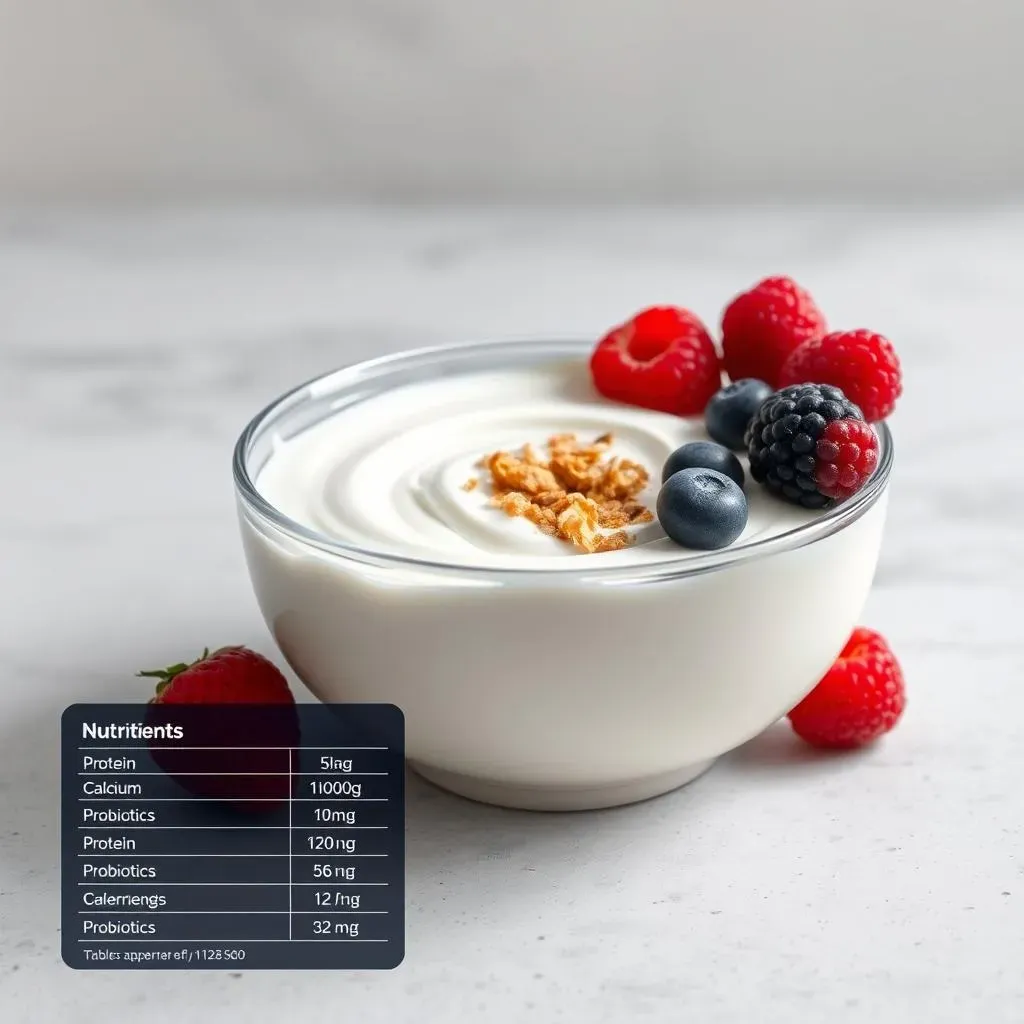Table of Contents
In a world brimming with dietary choices, yogurt often emerges as a frontrunner, celebrated for its creamy texture and potential health perks. But with a sea of options lining supermarket shelves, how do you navigate the nuances between full-fat, Greek, and the ever-popular low fat varieties? If you're on a quest for a nutritious snack that aligns with your wellness goals, then you've probably wondered about the low fat yogurt benefits. This isn't just about cutting calories; it's about understanding how this dairy delight can contribute to a balanced diet and overall well-being. This article dives deep into the world of low fat yogurt, exploring its nutritional composition, the science-backed health advantages, and how it stacks up against its full-fat counterpart. We'll also guide you on seamlessly integrating low fat yogurt into your daily meals with practical tips and tasty recipes. Whether you're aiming to boost your protein intake, support your digestive health, or simply seeking a guilt-free treat, prepare to uncover the full spectrum of low fat yogurt's potential. So, grab a spoon, and let's get started!
Unpacking the Nutritional Profile of Low Fat Yogurt
Unpacking the Nutritional Profile of Low Fat Yogurt
The Core Nutrients in Low Fat Yogurt
Low fat yogurt is a powerhouse of essential nutrients, making it a smart choice for health-conscious individuals. It's packed with protein, crucial for muscle building and repair, as well as calcium, vital for strong bones and teeth. Beyond these, you'll find a good dose of phosphorus, potassium, and various B vitamins, each playing a unique role in maintaining overall health. What sets low fat yogurt apart is that it delivers these nutrients while keeping the fat content minimal, making it an appealing option for those watching their fat intake.
Decoding the Label: What to Look For
Navigating the yogurt aisle can feel like deciphering a secret code! When choosing low fat yogurt, it's essential to become a label detective. Pay close attention to the sugar content, as some brands compensate for the lack of fat by adding excessive amounts of sugar. Look for yogurts with "live and active cultures," indicating the presence of beneficial probiotics. Also, check the protein content – Greek yogurt, even in its low fat form, typically boasts a higher protein concentration than regular yogurt.
Nutrient | Typical Amount (per 100g) | Benefit |
|---|---|---|
Protein | Around 10g | Muscle building, satiety |
Calcium | Around 120mg | Bone health |
Sugar | Varies (aim for <5g) | Energy source |
Probiotics | Varies (look for "live and active cultures") | Gut health |
Spotlight on Probiotics: The Gut-Friendly Factor
One of the most celebrated aspects of yogurt is its probiotic content. These beneficial bacteria play a crucial role in maintaining a healthy gut microbiome. A balanced gut flora is linked to improved digestion, enhanced immune function, and even mental well-being. Not all yogurts are created equal when it comes to probiotics, so be sure to choose brands that clearly state the presence of "live and active cultures" on the label. Incorporating low fat yogurt with probiotics into your diet can be a simple and delicious way to support your gut health.
The Surprising Health Benefits of Low Fat Yogurt
The Surprising Health Benefits of Low Fat Yogurt
Boosting Heart Health with Low Fat Yogurt
One of the most compelling low fat yogurt benefits lies in its potential to promote heart health. Studies suggest that regular consumption of yogurt, regardless of its fat content, can contribute to lower blood pressure and improved cholesterol levels. The potassium in yogurt helps regulate blood pressure, while the probiotics can positively influence cholesterol metabolism. Choosing low fat yogurt allows you to reap these cardiovascular benefits without the added saturated fat, making it a heart-smart choice.
Ever wonder how something so simple could make a difference? Think of it as a small, consistent act of kindness towards your heart. It's not a magic bullet, but it's a delicious way to support your cardiovascular system alongside a balanced diet and active lifestyle.
Weight Management: Aiding Your Goals with Low Fat Yogurt
If you're on a weight management journey, low fat yogurt can be a valuable ally. Its high protein content promotes satiety, helping you feel fuller for longer and reducing the likelihood of overeating. Additionally, the calcium in yogurt may play a role in fat metabolism. Opting for low fat versions ensures you're getting these benefits without excess calories from fat, making it easier to maintain a calorie deficit.
I always tell my friends who are trying to lose weight, don't think of low fat yogurt as a diet food, think of it as a tool. A tool that helps you feel satisfied, gives you a boost of protein, and supports your overall health. Plus, it's way more enjoyable than forcing down bland, tasteless "diet" foods.
Benefit | How Low Fat Yogurt Helps |
|---|---|
Increased Satiety | High protein content keeps you feeling full. |
Reduced Calorie Intake | Lower fat content compared to full-fat options. |
Potential Fat Metabolism Support | Calcium may play a role in fat breakdown. |
Strengthening Bones and Immunity
Beyond heart health and weight management, low fat yogurt benefits extend to bone strength and immune function. The calcium in yogurt is essential for maintaining strong and healthy bones, reducing the risk of osteoporosis. Furthermore, the probiotics in yogurt can bolster your immune system by promoting a healthy gut microbiome. A balanced gut flora helps your body fight off infections and illnesses more effectively.
It's like giving your body a little army of good bacteria to defend against the bad guys. And who doesn't want a stronger, more resilient body? Plus, strong bones are essential for staying active and enjoying life to the fullest.
Low Fat Yogurt vs. Full Fat: Which is Right for You?
Low Fat Yogurt vs. Full Fat: Which is Right for You?
The Great Debate: Fat Content and Health
The showdown between low fat and full fat yogurt is a hot topic in the nutrition world. For years, low fat options were touted as the healthier choice, primarily due to concerns about saturated fat and its impact on heart health. However, recent research has challenged this long-held belief. Some studies suggest that the saturated fat in dairy products may not be as detrimental as previously thought, and that full fat yogurt may even offer certain benefits. So, which one should you choose?
It's like that classic "are eggs good or bad for you?" debate. The answer, as with most things in nutrition, is nuanced and depends on individual factors.
Weighing the Pros and Cons
Let's break down the advantages and disadvantages of each type of yogurt to help you make an informed decision. Low fat yogurt typically contains fewer calories and less saturated fat, making it a suitable option for those closely monitoring their fat intake or aiming to reduce their overall calorie consumption. However, as mentioned earlier, some low fat yogurts compensate for the lack of fat by adding sugar, which can negate some of the health benefits. Full fat yogurt, on the other hand, tends to be more satiating due to its higher fat content, potentially leading to reduced overall calorie intake. It also contains fat-soluble vitamins, which are better absorbed when consumed with fat.
Yogurt Type | Pros | Cons |
|---|---|---|
Low Fat Yogurt | Lower in calories and saturated fat, good source of protein and calcium. | May contain added sugar to compensate for lack of fat. |
Full Fat Yogurt | More satiating, contains fat-soluble vitamins, may have a more natural flavor. | Higher in calories and saturated fat. |
Personalizing Your Choice
Ultimately, the best choice between low fat and full fat yogurt depends on your individual needs, preferences, and dietary goals. If you're carefully watching your calorie or fat intake, low fat yogurt can be a good option, provided you choose a brand with minimal added sugar. If you prioritize satiety and enjoy the richer flavor of full fat yogurt, it can be a perfectly healthy choice as part of a balanced diet. Consider your overall eating habits and lifestyle when making your decision. There's no one-size-fits-all answer!
I always tell people, listen to your body! What makes you feel good? What fits into your lifestyle? Nutrition isn't about rigid rules, it's about finding what works best for you.
Incorporating Low Fat Yogurt into Your Diet: Tips and Recipes
Incorporating Low Fat Yogurt into Your Diet: Tips and Recipes
Breakfast Bliss: Starting Your Day Right
Low fat yogurt is a fantastic way to kickstart your morning. Forget sugary cereals and processed pastries! A simple yogurt bowl with a handful of berries and a sprinkle of granola provides sustained energy and a boost of essential nutrients. Get creative with toppings – chia seeds, flax seeds, nuts, and a drizzle of honey can add flavor and texture. For a grab-and-go option, blend low fat yogurt with fruit and a scoop of protein powder for a quick and satisfying smoothie. It's a blank canvas for your breakfast masterpiece!
I always tell people, breakfast is your chance to set the tone for the whole day. Fuel your body with something nutritious and delicious, and you'll be amazed at how much better you feel.
- Yogurt Bowl: Low fat yogurt, berries, granola, chia seeds
- Smoothie: Low fat yogurt, banana, spinach, protein powder
- Parfait: Layer low fat yogurt with fruit and granola in a glass
Savory Sensations: Beyond the Sweet
Don't limit low fat yogurt to just sweet applications! It can be a surprisingly versatile ingredient in savory dishes. Use it as a base for creamy salad dressings, a healthier alternative to mayonnaise or sour cream. Mix it with herbs and spices to create flavorful dips for vegetables or grilled meats. In Indian cuisine, yogurt is a key component of raita, a cooling condiment that complements spicy dishes. Experiment with different flavors and textures to discover the savory side of low fat yogurt.
Think outside the yogurt cup! It's not just for breakfast or snacks. A dollop of yogurt can add a touch of richness and tang to so many savory meals.
Smart Snacking: Curbing Cravings the Healthy Way
When those afternoon cravings hit, reach for low fat yogurt instead of processed snacks. It's a satisfying and nutritious way to tide you over until your next meal. Pair it with a piece of fruit, a handful of nuts, or some whole-grain crackers for a balanced and filling snack. For a fun and refreshing treat, freeze low fat yogurt in popsicle molds with fruit chunks or a swirl of honey. It's a guilt-free way to satisfy your sweet tooth and keep you on track with your health goals.
Snacking doesn't have to be a guilty pleasure! Choose snacks that nourish your body and keep you feeling energized. Low fat yogurt is a perfect example of a snack that's both delicious and good for you.
Snack Idea | Ingredients |
|---|---|
Yogurt with Fruit | Low fat yogurt, berries, sliced banana |
Yogurt with Nuts | Low fat yogurt, almonds, walnuts |
Frozen Yogurt Pops | Low fat yogurt, fruit, honey |
Conclusion: Savoring the Low Fat Yogurt Benefits
From bolstering bone health to aiding weight management and promoting a thriving gut microbiome, the benefits of low fat yogurt are vast and varied. As we've explored, this dairy product offers a compelling nutritional profile, making it a worthy addition to a balanced diet. While the debate between low fat and full-fat options continues, understanding your individual dietary needs and health goals is key to making the right choice. Remember to opt for plain, unsweetened varieties to maximize the health advantages and minimize added sugars. So, go ahead, embrace the creamy goodness of low fat yogurt and enjoy the delicious journey to a healthier you!
